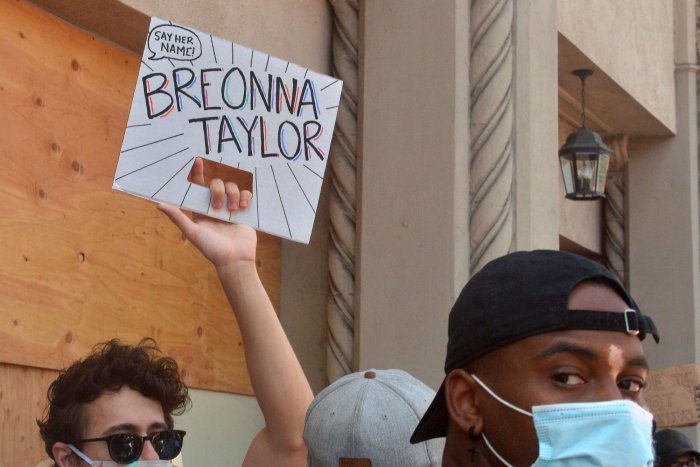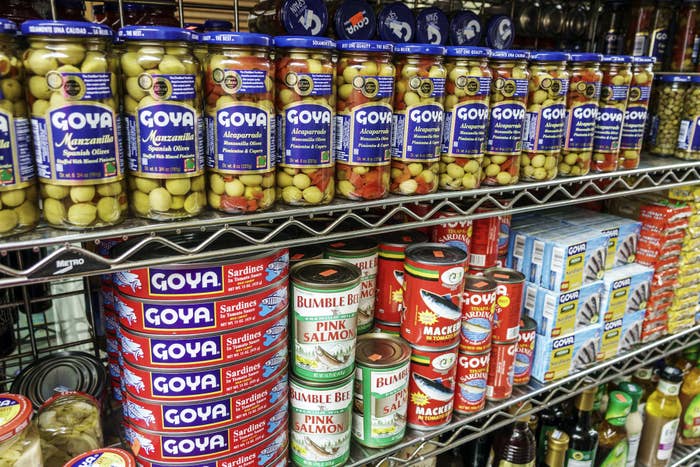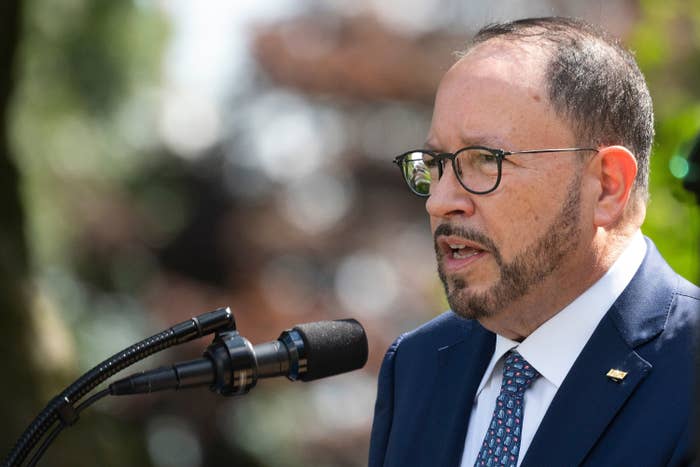COVID-19: Serbia arrests 71 in protest over handling of pandemic
By Sommer Brokaw

Police face off with protestors during the protest against the strict measures to fight the coronavirus in Belgrade, Serbia, on Friday. Photo by Andrej Cukic/EPA-EFE
July 11 (UPI) -- Serbian police said they've arrested 71 people involved in protests over the government's handling of the coronavirus pandemic.
Protesters began taking to the streets Tuesday after President Aleksandar Vučić announced that Belgrade would be placed on a weekend curfew to curb COVID-19 spread. Vučić also declared that more than 2 million people will need to be vaccinated before the fall to prepare for a second wave of the virus.
The protests quickly morphed into a wider movement against Vučić's alleged mismanagement of the pandemic despite his decision to suspend a second shutdown. Protesters said they were angry about government steps, such as proceeding with the general election last week, restarting large sport events and reopening nightclubs too early, which they believe led to the need for another lockdown.

Serbian riot police guard the Serbian parliament building during a protest in Belgrade, Serbia, Friday, July 10 2020. Hundreds of demonstrators tried to storm Serbia's parliament on Friday, clashing with police who fired tear gas during the fourth night of protests against the president's increasingly authoritarian rule. The protests started on Tuesday when President Aleksandar Vucic announced that Belgrade would be placed under a new three-day lockdown following a second wave of confirmed coronavirus infections. (AP Photo/Darko Vojinovic
Protests continued for a fourth day Friday. Thousands of people demonstrated in several cities, with protesters in the capital, hurling stones at police in front of Parliament. In Friday's clashes, 14 police officers were injured with 130 police injured since Tuesday.
Some protesters entered the Parliament building Tuesday night before being forced out by police. Film footage later appeared to show police beating unarmed protesters with batons.
Figures on the number of protesters injured have not been released.
Serbia has reported 17,728 cases of COVID-19 and 370 deaths from the virus, according to Johns Hopkins University global tracker.
 Protesters clash with riot police on the steps of the Serbian parliament during a protest in Belgrade, Serbia, Friday, July 10 2020. Hundreds of demonstrators tried to storm Serbia's parliament on Friday, clashing with police who fired tear gas during the fourth night of protests against the president's increasingly authoritarian rule. The protests started on Tuesday when President Aleksandar Vucic announced that Belgrade would be placed under a new three-day lockdown following a second wave of confirmed coronavirus infections. (AP Photo/Darko Vojinovic)
Protesters clash with riot police on the steps of the Serbian parliament during a protest in Belgrade, Serbia, Friday, July 10 2020. Hundreds of demonstrators tried to storm Serbia's parliament on Friday, clashing with police who fired tear gas during the fourth night of protests against the president's increasingly authoritarian rule. The protests started on Tuesday when President Aleksandar Vucic announced that Belgrade would be placed under a new three-day lockdown following a second wave of confirmed coronavirus infections. (AP Photo/Darko Vojinovic)
BELGRADE, Serbia (AP) — Serbian police detained 71 people after clashes during the fourth night of anti-government protests against the Serbian president that were initially sparked by his plans to reintroduce a coronavirus lockdown.
Fourteen policemen were injured in the rioting Friday evening when hundreds of right-wing demonstrators tried to storm the parliament building in downtown Belgrade, police director Vladimir Rebic said Saturday. Many demonstrators and several reporters were also injured in the protests.
Hundreds gathered on Saturday for another night of protests when no incidents were reported.
Serbian media reported that among the detained was a former parliament member and one of the leaders of the violent protesters, pro-Russian far-right politician Srdjan Nogo.

Serbian riot police guard the Serbian parliament building during a protest in Belgrade, Serbia, Friday, July 10 2020. Hundreds of demonstrators tried to storm Serbia's parliament on Friday, clashing with police who fired tear gas during the fourth night of protests against the president's increasingly authoritarian rule. The protests started on Tuesday when President Aleksandar Vucic announced that Belgrade would be placed under a new three-day lockdown following a second wave of confirmed coronavirus infections. (AP Photo/Darko Vojinovic)
The protesters, defying an anti-virus ban on gatherings, threw bottles, rocks and flares at police who were guarding the parliament building, and police responded with tear gas to disperse the angry crowds.
Similar clashes erupted twice earlier this week. The protests first started when populist President Aleksandar Vucic announced a strict curfew for this weekend to curb a surge in new coronavirus cases in the Balkan country
Vucic later scraped the plan to impose the lockdown. Authorities instead banned gatherings of more than 10 people in Belgrade, the capital, and shortened the working hours of indoor businesses.

Protesters clash with riot police on the steps of the Serbian parliament during a protest in Belgrade, Serbia, Friday, July 10 2020. Hundreds of demonstrators tried to storm Serbia's parliament on Friday, clashing with police who fired tear gas during the fourth night of protests against the president's increasingly authoritarian rule. The protests started on Tuesday when President Aleksandar Vucic announced that Belgrade would be placed under a new three-day lockdown following a second wave of confirmed coronavirus infections. (AP Photo/Darko Vojinovic)
Protesters clash with riot police on the steps of the Serbian parliament during a protest in Belgrade, Serbia, Friday, July 10 2020. Hundreds of demonstrators tried to storm Serbia's parliament on Friday, clashing with police who fired tear gas during the fourth night of protests against the president's increasingly authoritarian rule. (AP Photo/Darko Vojinovic)
Many in Serbia accuse the increasingly authoritarian Vucic and his government of letting the virus crisis spin out of control in order to hold a parliamentary election on June 21 that tightened the ruling party’s grip on power.
Vucic has denied this, although authorities had relaxed the rules prior to the vote, allowing massive crowds at soccer games, tennis matches and nightclubs.
Authorities reported 12 new coronavirus deaths on Saturday and 354 new infections, although there have been increasing doubts about the accuracy of the official figures.
The country officially has over 18,000 confirmed infections and 382 deaths since March. Health authorities have warned that Serbian hospitals are almost full due to the latest surge in cases.
Vucic has claimed that unspecified foreign security services were involved in the unrest and pledged he won’t be toppled in the streets. Some opposition leaders, meanwhile, are blaming the rioting on groups they say are controlled by the government to discredit peaceful protests.
Rebic said foreign citizens are among those detained, including people from Montenegro, Bosnia, Britain and Tunisia. He said police are looking into “foreign element in the radicalization of the protests.”
Protesters clash with riot police on the steps of the Serbian parliament during a protest in Belgrade, Serbia, Friday, July 10 2020. Hundreds of demonstrators tried to storm Serbia's parliament on Friday, clashing with police who fired tear gas during the fourth night of protests against the president's increasingly authoritarian rule. The protests started on Tuesday when President Aleksandar Vucic announced that Belgrade would be placed under a new three-day lockdown following a second wave of confirmed coronavirus infections. (AP Photo/Darko Vojinovic)
Pro-government tabloids in Serbia have claimed that Russian intelligence services were behind the unrest that is designed to destabilize the country as Western efforts mount to negotiate an deal normalizing relations with Kosovo, Serbia’s former province whose 2008 declaration of independence Belgrade still does not recognize.
Serbia is a rare Russian ally in Europe with historically close Slavic ties. The country is bidding to join the European Union after years of crisis and wars in the 1990s. Nationalist and far-right groups in Serbia are opposed to EU membership and want closer ties with Russia instead.
The Russian foreign ministry has vehemently denied any involvement in the latest protests in Serbia.

Protesters clash with riot police on the steps of the Serbian parliament during a protest in Belgrade, Serbia, Friday, July 10 2020. Hundreds of demonstrators tried to storm Serbia's parliament on Friday, clashing with police who fired tear gas during the fourth night of protests against the president's increasingly authoritarian rule. (AP Photo/Darko Vojinovic)




























